↘
PLACE—
MAKING—
PLACE
New approaches to the city.
What is the significance of a place for the people who use it? What
motivates people to live in a place, to appropriate it, to get involved, to
care for it?
The term placemaking covers various theories and approaches to the planning, design and management of public spaces. The aim is to create public spaces that improve urban coexistence and promote the health, happiness and well-being of its inhabitants. Special attention is paid to the potential and inspiration of a local community. Unused space is (re) used to change the human experience of a place, ultimately a city, and thus shape new behaviors (1).
Using the example of the THWS Sanderheinrichsleitenweg (SHL) campus as a (semi-)public space, the potential of the courtyard for our community, our togetherness and our SHL microcosm was explored in concrete terms. Prototypes were used to deliberately test aspects of production, usability and lifecycles of products, as well as the narratives and visions surrounding places.
The term placemaking covers various theories and approaches to the planning, design and management of public spaces. The aim is to create public spaces that improve urban coexistence and promote the health, happiness and well-being of its inhabitants. Special attention is paid to the potential and inspiration of a local community. Unused space is (re) used to change the human experience of a place, ultimately a city, and thus shape new behaviors (1).
Using the example of the THWS Sanderheinrichsleitenweg (SHL) campus as a (semi-)public space, the potential of the courtyard for our community, our togetherness and our SHL microcosm was explored in concrete terms. Prototypes were used to deliberately test aspects of production, usability and lifecycles of products, as well as the narratives and visions surrounding places.
(1)
A three-part series of workshops ↗ with the artist Katharina Lüdicke ↗ took place as part of the course. Urban space was explored using ad hoc interventions.
Supervision Prof. Judith Glaser
Winter Term 2024/25
A three-part series of workshops ↗ with the artist Katharina Lüdicke ↗ took place as part of the course. Urban space was explored using ad hoc interventions.
Supervision Prof. Judith Glaser
Winter Term 2024/25
↘

Gesehen & Ignoriert
Luca Hurrle, Sebastian Meier
Wir möchten mit euch über Wohnungslosigkeit sprechen – ein Thema, das in unserer Gesellschaft oft übersehen wird. Es begegnet uns tagtäglich und erhält dennoch viel zu wenig Aufmerksamkeit.
In diesem Podcast ↗ haben wir mit Menschen aus verschiedenen Organisationen und wichtigen Strukturen gesprochen, um einen Einblick in ihre alltägliche Arbeit zu bekommen und unterschiedliche Perspektiven zu beleuchten – ehrlich, respektvoll und auf Augenhöhe. Unsere Gesprächspartner*innen kamen aus vielfältigen Bereichen: der Wärmestube, der Bahnhofsmission, der Anlaufstelle Underground, dem Haus Antonia Werr, der Elisabethstube der Erlöserschwestern sowie der Zentralen Beratungsstelle für Wohnungslose.
In diesem Podcast ↗ haben wir mit Menschen aus verschiedenen Organisationen und wichtigen Strukturen gesprochen, um einen Einblick in ihre alltägliche Arbeit zu bekommen und unterschiedliche Perspektiven zu beleuchten – ehrlich, respektvoll und auf Augenhöhe. Unsere Gesprächspartner*innen kamen aus vielfältigen Bereichen: der Wärmestube, der Bahnhofsmission, der Anlaufstelle Underground, dem Haus Antonia Werr, der Elisabethstube der Erlöserschwestern sowie der Zentralen Beratungsstelle für Wohnungslose.
Uns war es wichtig, ein möglichst umfassendes Bild der Hilfsstrukturen aufzuzeigen und Menschen zum aktiven Handeln zu motivieren. Einen weiteren Perspektivwechsel bekommen die Zuhörer*innen durch Gespräche mit Menschen, die noch keinerlei Berührungspunkte mit diesem Thema hatten.
Um auf das projekttragende Medium aufmerksam zu machen, haben wir verschiedene Plakatentwürfe entwickelt. Da wir eine breite Zielgruppe ansprechen möchten, haben wir uns für ein cleanes, ein verspieltes und ein poppiges Design entschieden. In einem Faltblatt wird man durch das Projektkonzept und weitere Informationen geführt.
Um auf das projekttragende Medium aufmerksam zu machen, haben wir verschiedene Plakatentwürfe entwickelt. Da wir eine breite Zielgruppe ansprechen möchten, haben wir uns für ein cleanes, ein verspieltes und ein poppiges Design entschieden. In einem Faltblatt wird man durch das Projektkonzept und weitere Informationen geführt.



↘

DIY Kitchen Solutions
Bayan Shannak
As an exchange student in Germany, one of my biggest challenges was adapting to small living spaces, particularly the limited kitchen counter. Cooking in such a cramped area was frustrating and time-consuming. The main struggles I faced were the small counter itself and the hot stove, which took a long time to cool down, making it difficult to manage space efficiently.
To address these issues, I developed a project that focuses on two key aspects: maximizing counter functionality and creating a practical solution for the lingering heat from the stove. My goal is not just to design a product but to emphasize the idea of using existing materials creatively. I want to inspire other students facing similar challenges to customize their spaces based on their specific needs without relying on costly solutions. When designing the product, I first identified my personal needs.
To address these issues, I developed a project that focuses on two key aspects: maximizing counter functionality and creating a practical solution for the lingering heat from the stove. My goal is not just to design a product but to emphasize the idea of using existing materials creatively. I want to inspire other students facing similar challenges to customize their spaces based on their specific needs without relying on costly solutions. When designing the product, I first identified my personal needs.
I wanted a safe and comfortable way to cover the stove, allowing me to utilize that space when it wasnít in use. Additionally, I needed a convenient place to store my cooking utensils, such as spatulas and spoons, for easy access. Another consideration was finding a suitable spot to hang onions and other vegetables stored in mesh bags, as my small kitchen lacked proper storage.
This project serves as a practical example of how small, thoughtful modifications can improve the cooking experience in tiny kitchens. Rather than focusing on the final product, my aim is to encourage students to rethink and optimize their spaces by making the most of what they already have. With creative problem-solving, even the most limited kitchen setup can become more functional and efficient.
This project serves as a practical example of how small, thoughtful modifications can improve the cooking experience in tiny kitchens. Rather than focusing on the final product, my aim is to encourage students to rethink and optimize their spaces by making the most of what they already have. With creative problem-solving, even the most limited kitchen setup can become more functional and efficient.



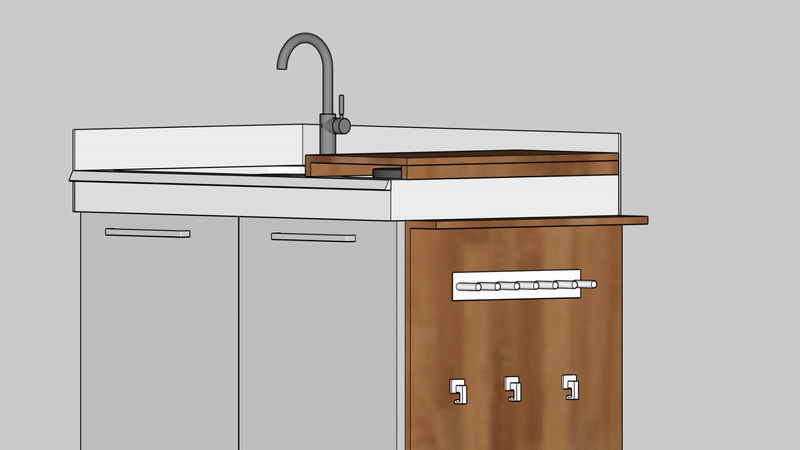
↘

stadt halten
Franziska Schön , Sophia Böhm, Viola Messner
Our project aims to get people waiting at bus stop out of their daily routine and tunnel vision. To achieve this, we chose the Mainfrankentheater bus stop and intervened on-site with three different installations: a tic-tac-toe game, a board to note down New Year’s wishes, and a speaker featuring various music genres.
Both our observations and interviews with participants revealed that we achieved our goal. The entire process was visuallized and documented in the magazine stadt halten. This publication captures the reactions and atmosphere at the bus stop, making them relatable.
Both our observations and interviews with participants revealed that we achieved our goal. The entire process was visuallized and documented in the magazine stadt halten. This publication captures the reactions and atmosphere at the bus stop, making them relatable.



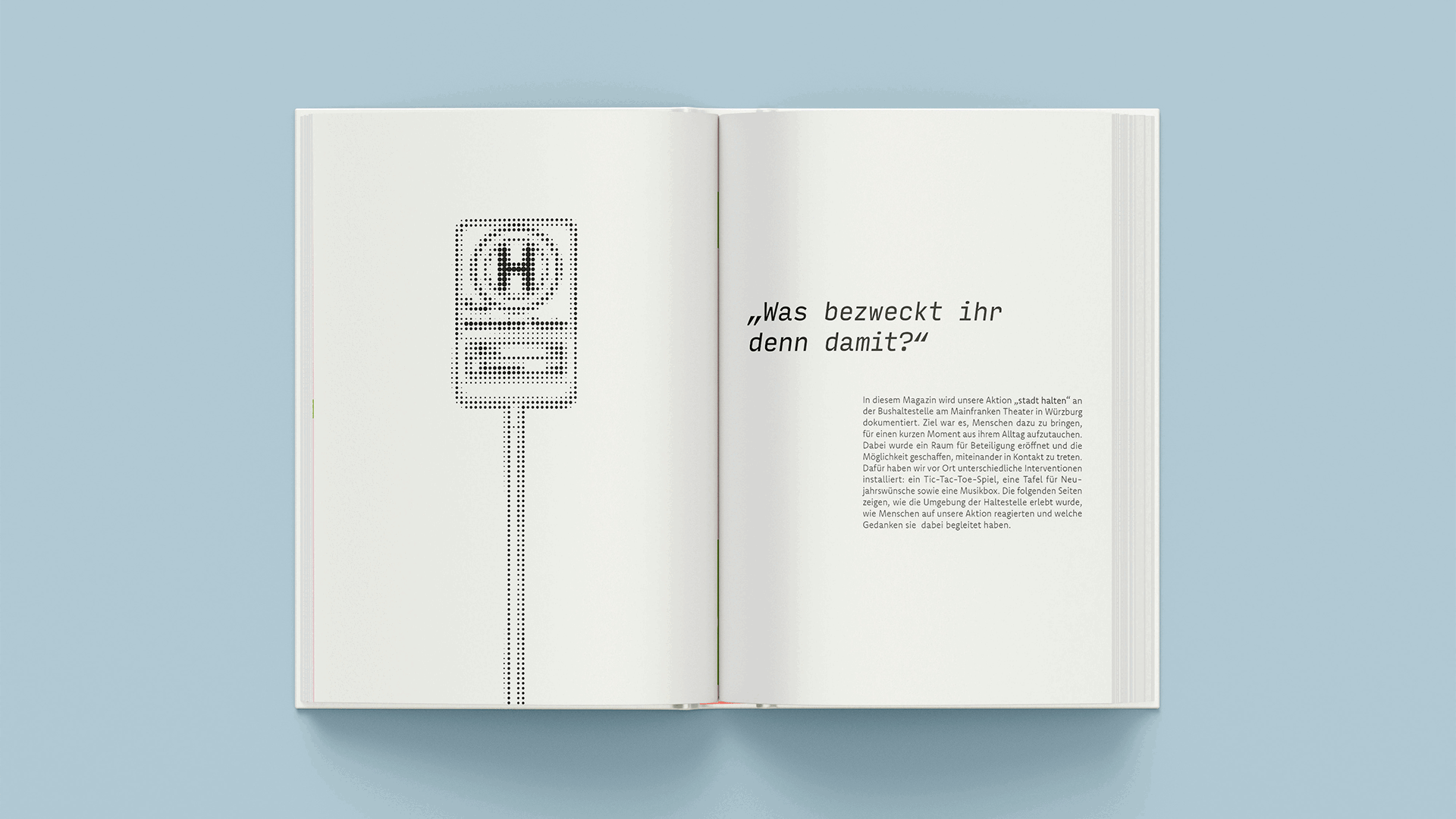
Oh, Würzburg – manchmal ist es so schwer, Veranstaltungen zu finden, vor allem, wenn man nicht
weiß, wo man suchen soll.
Mir ist aufgefallen, dass es in den meisten Städten – so auch in Würzburg – keine Plattform für
kleine und alternative Veranstaltungen gibt. Wenn du nicht in der Szene bist, ist es nahezu
unmöglich, die versteckten Orte zu entdecken.
Dieses Problem besteht auf beiden Seiten: Nicht nur die Suchenden, sondern auch die
Veranstaltenden wissen oft nicht, wie und wo sie ihr Publikum erreichen können. Genau hier setze
ich an. Meine Aufgabe ist es, diese beiden Gruppen auf einer Plattform zusammenzuführen. Was
hebt hoerensagen von anderen Plattformen ab?
Veranstaltende haben die Möglichkeit, schnell und
unkompliziert Inserate hochzuladen. Oft fehlt es an Zeit und Ressourcen – genau deshalb
übernimmt meine Plattform auch die Erstellung von Werbemitteln und Designs. Durch einfaches
Anklicken von Keywords wird automatisch eine passende Grafik generiert, die sich nahtlos in das
standardisierte Layout einfügt. Neben den digitalen Grafiken können auch analoge Werbemittel
wie Flyer, Poster und Sticker bestellt werden. hoerensagen passiert meist unter Freunden oder
Bekannten – und genau dieses Gefühl spiegelt sich in der Plattform wider. Die Sprache ist
freundschaftlich, locker und nahbar.



↘

FlexBench
Julius Gerber
Die Grundidee für dieses Projekt entstand im vorherigen Semester im Rahmen eines Kurses, der sich mit Möbeln für die THWS beschäftigte. Bereits dort experimentierte ich mit Gurten als flexibles Möglichkeiten zur Anpassungsfähigkeit von Sitzmöbeln. Diese ersten Überlegungen und Materialien bildeten die Basis für die Weiterentwicklung hin zu einer modularen Sitzmöglichkeit, die sich dynamisch an verschiedene Formen anpasst.
Der Entstehungsprozess begann mit ersten Skizzen, um verschiedene Ansätze für eine flexible Sitzlösung zu erkunden. Dabei spielte die Verbindung aus Holzstreben und Gurten eine zentrale Rolle. Nach der Skizzenphase fertigte ich ein kleines Modell aus Pappe, um die Funktionalität und Mechanik in einem ersten physischen Test nachvollziehen zu können. Um die Formensprache und die Konstruktion weiter zu präzisieren, baute ich das Modell anschließend in Blender nach. Dort konnte ich verschiedene Konfigurationen digital ausprobieren, bevor ich mit der Detailausarbeitung fortfuhr.
Der Entstehungsprozess begann mit ersten Skizzen, um verschiedene Ansätze für eine flexible Sitzlösung zu erkunden. Dabei spielte die Verbindung aus Holzstreben und Gurten eine zentrale Rolle. Nach der Skizzenphase fertigte ich ein kleines Modell aus Pappe, um die Funktionalität und Mechanik in einem ersten physischen Test nachvollziehen zu können. Um die Formensprache und die Konstruktion weiter zu präzisieren, baute ich das Modell anschließend in Blender nach. Dort konnte ich verschiedene Konfigurationen digital ausprobieren, bevor ich mit der Detailausarbeitung fortfuhr.
Durch gerenderte Bilder aus verschiedenen Perspektiven wurde die visuelle Darstellung des Designs weiter verfeinert. Um die Materialität und die Funktion der Sitzmöglichkeit interaktiv erlebbar zu machen, beschäftigte ich mich mit Augmented Reality (AR). Die Idee war, das digitale Modell in den realen Raum zu integrieren, sodass Nutzer:innen es direkt in ihrer Umgebung betrachten können. AR ermöglicht eine realistische Darstellung von Materialien und Größenverhältnissen, bevor es physisch gebaut wird.
Um die Handhabung der Sitzmöglichkeit so intuitiv wie möglich zu gestalten, wurde eine Anleitung entwickelt, die komplett ohne Text auskommt. Stattdessen wird der Aufbau und die Anwendung durch klare, reduzierte Illustrationen vermittelt. Durch diese klare Bildsprache wird sichergestellt, dass die Sitzmöglichkeit einfach verständlich und ohne lange Erklärungen direkt nutzbar ist.
Um die Handhabung der Sitzmöglichkeit so intuitiv wie möglich zu gestalten, wurde eine Anleitung entwickelt, die komplett ohne Text auskommt. Stattdessen wird der Aufbau und die Anwendung durch klare, reduzierte Illustrationen vermittelt. Durch diese klare Bildsprache wird sichergestellt, dass die Sitzmöglichkeit einfach verständlich und ohne lange Erklärungen direkt nutzbar ist.
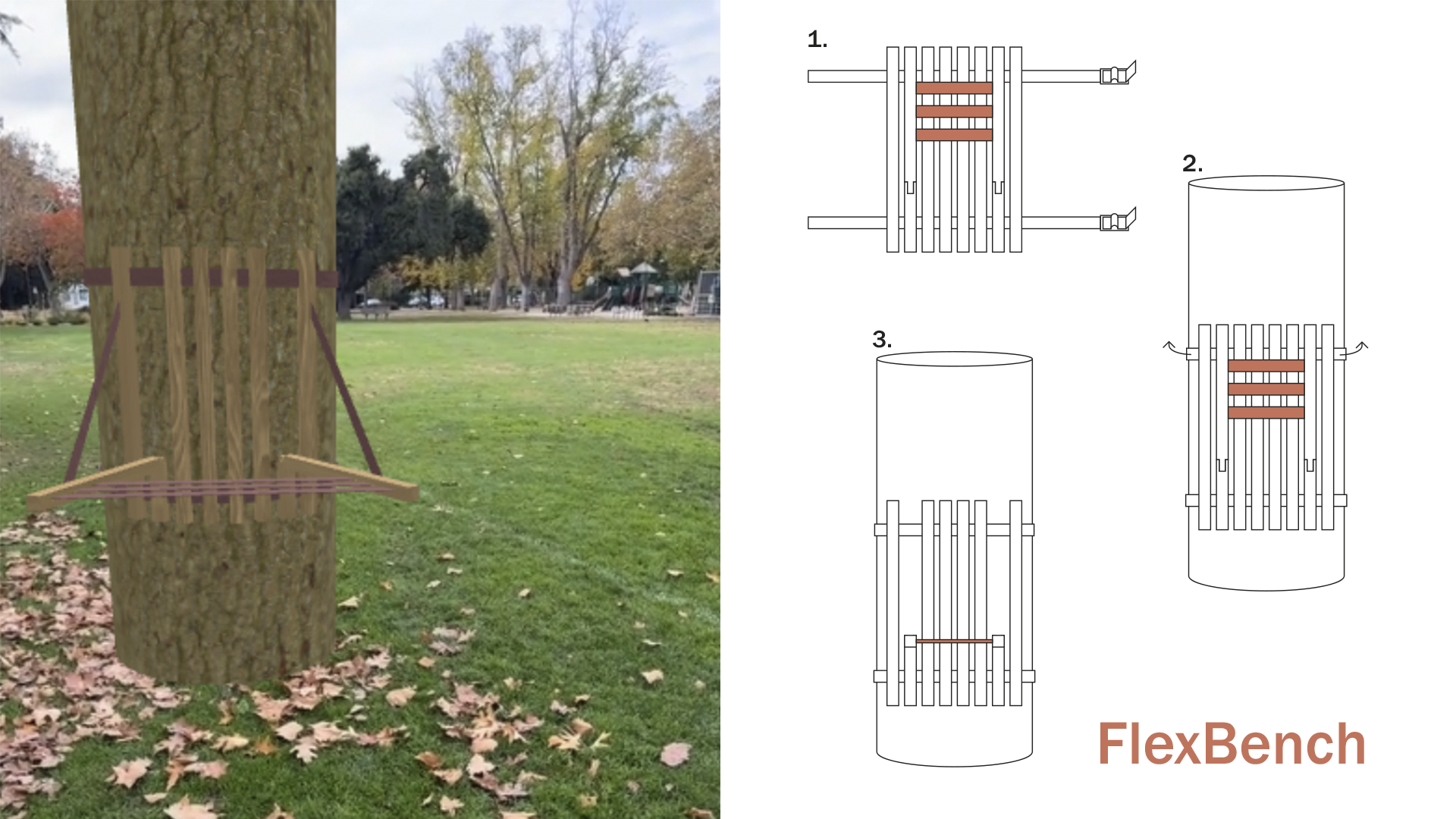

↘
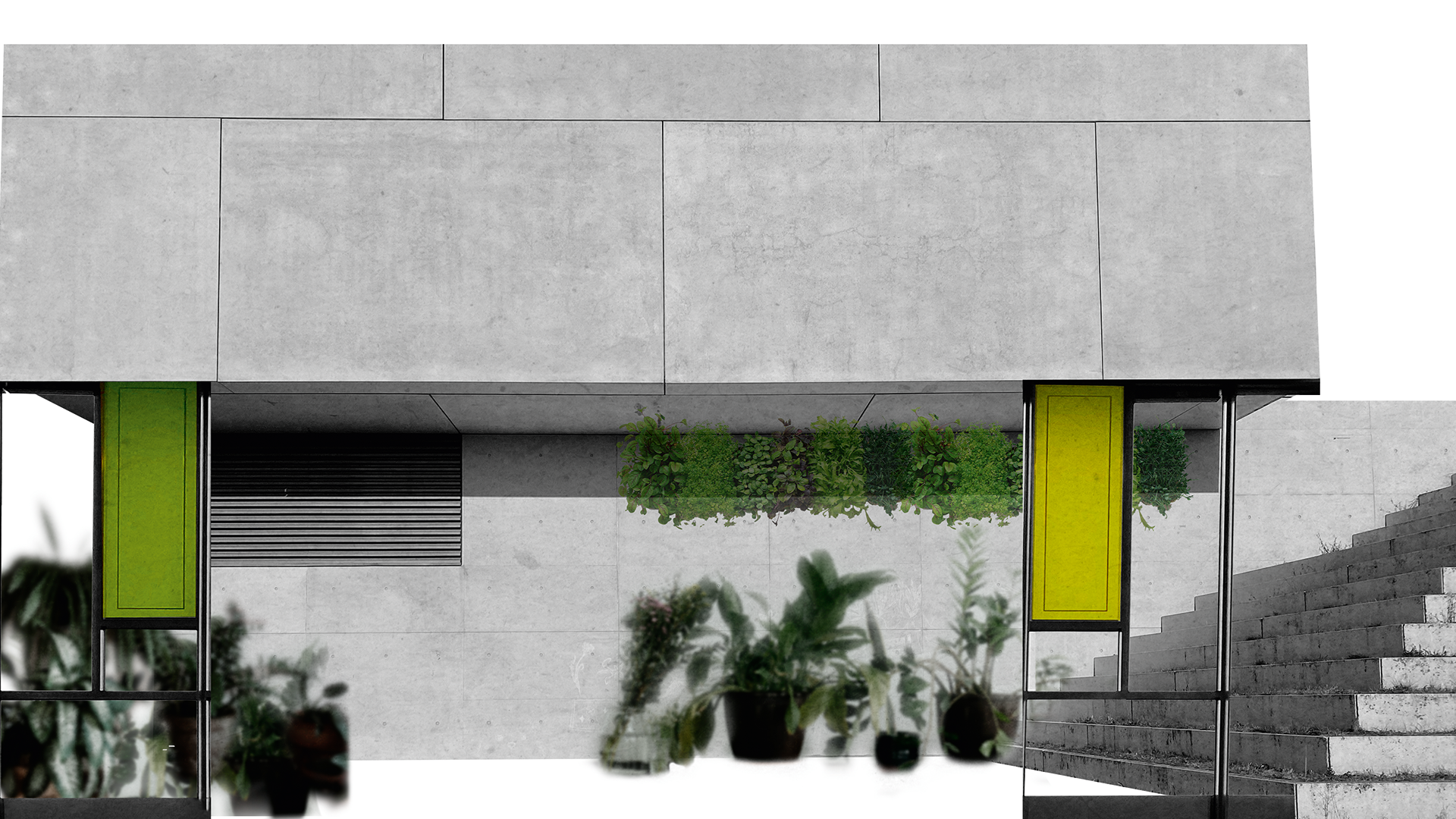
The Garden
Johanna Fluhrer, Yasmeen Alkayyali, Mia Venn
The project The Garden developed out of a longing to escape the stress of everyday life at university. When researching stress-relieving factors, plants and nature in general have become a decisive factor. With this vision, we thought about the care, financing, design and organization of the winter garden.
When designing the conservatory, our focus was on the multifunctional use of the space. It should serve as a relaxing retreat in everyday life as well as being able to be used flexibly for special events. A central aspect of the concept was to take into account the different seasons in order to ensure year-round attractiveness and use. Intensive research was required to make The Garden appealing and functional for the various target groups. We analyzed the needs of the users and carried out prototyping to test and adapt design elements.
When designing the conservatory, our focus was on the multifunctional use of the space. It should serve as a relaxing retreat in everyday life as well as being able to be used flexibly for special events. A central aspect of the concept was to take into account the different seasons in order to ensure year-round attractiveness and use. Intensive research was required to make The Garden appealing and functional for the various target groups. We analyzed the needs of the users and carried out prototyping to test and adapt design elements.
This user-centered approach results in a space that is not only aesthetically pleasing, but also meets the requirements for comfort, functionality and sustainability.
The Garden is a vibrant green space on campus that fosters relaxation, creativity, and community connection. Serving as a hub for workshops, cultural events, and outdoor activities, it bridges academic life with the city. Through partnerships and events, it generates financial sustainability, enhances student well-being, and romotes sustainability. As a strategic project, it strengthens the university‘s reputation as an innovative leader in education, community engagement, and global sustainability.
The Garden is a vibrant green space on campus that fosters relaxation, creativity, and community connection. Serving as a hub for workshops, cultural events, and outdoor activities, it bridges academic life with the city. Through partnerships and events, it generates financial sustainability, enhances student well-being, and romotes sustainability. As a strategic project, it strengthens the university‘s reputation as an innovative leader in education, community engagement, and global sustainability.


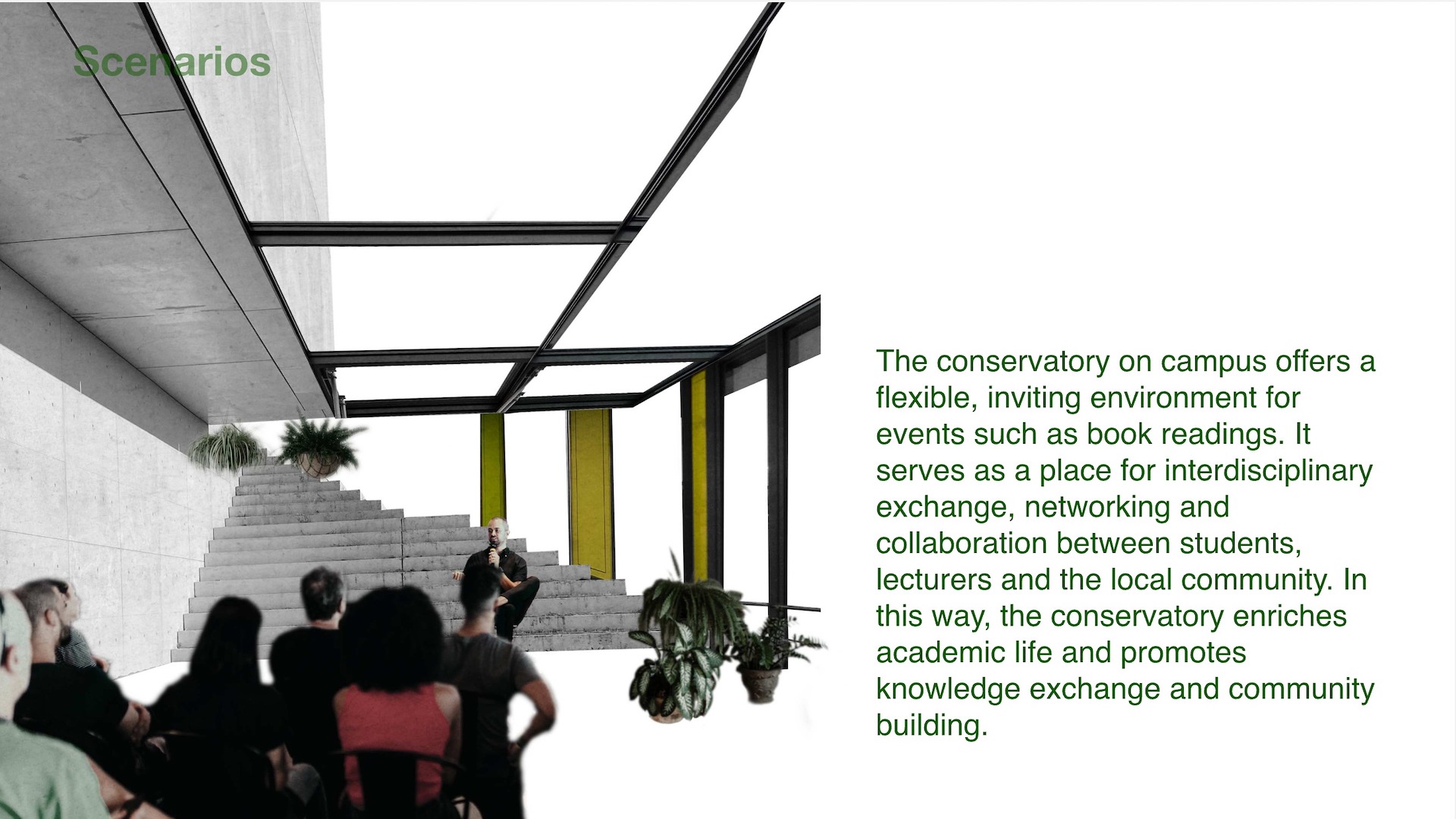
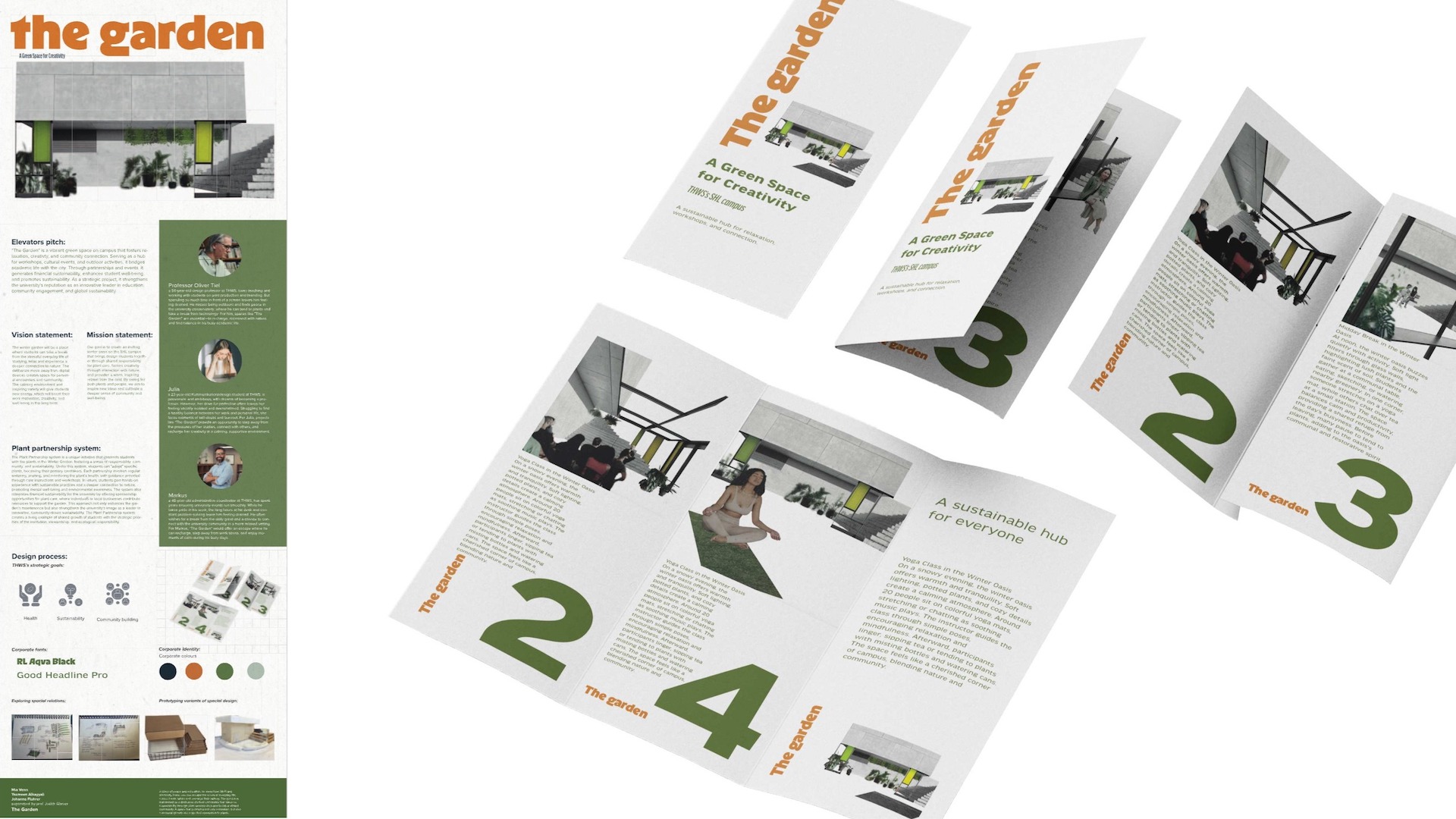
↘

Skatepark Zellerau 2.0
Nicklas Lutz
In unserem Kurs Place Making Place habe ich mich für ein Upgrade des Skateparks an den Zellerauer Mainwiesen entschieden. Ziel war es, einen Ort zu schaffen, der Skateboardern, Familien und Kindern gleichermaßen gerecht wird und eine friedliche Koexistenz ermöglicht.
Mein Konzept kombiniert sowohl ästhetische als auch funktionale Elemente. Im Mittelpunkt steht der überdachte Chillout-Bereich mit Sitzgelegenheiten, einem Wasserspender und ausreichend Schatten an heißen Tagen. Diese Elemente sorgen dafür, dass sich nicht nur Skater, sondern auch Familien mit ihren Kindern wohlfühlen. Ein Kernelement, das mir besonders wichtig war, ist die spielerische Abgrenzung zwischen der Skatefläche und den Aufenthaltsbereichen. Geländer mit durchbrochenen Elementen ermöglichen es Kindern, das Geschehen auf dem Skatepark sicher zu beobachten, ohne die befahrbare Fläche zu betreten.
Mein Konzept kombiniert sowohl ästhetische als auch funktionale Elemente. Im Mittelpunkt steht der überdachte Chillout-Bereich mit Sitzgelegenheiten, einem Wasserspender und ausreichend Schatten an heißen Tagen. Diese Elemente sorgen dafür, dass sich nicht nur Skater, sondern auch Familien mit ihren Kindern wohlfühlen. Ein Kernelement, das mir besonders wichtig war, ist die spielerische Abgrenzung zwischen der Skatefläche und den Aufenthaltsbereichen. Geländer mit durchbrochenen Elementen ermöglichen es Kindern, das Geschehen auf dem Skatepark sicher zu beobachten, ohne die befahrbare Fläche zu betreten.
So wird die Sicherheit erhöht, während der Bereich optisch offen und einladend bleibt. Ergänzt wird das Design durch eine Tafel mit klar, aber locker formulierten Regeln, die das harmonische Miteinander fördern sollen. Materialien wie Holz, kombiniert mit hellen, offenen Strukturen, verleihen dem Bereich eine freundliche Atmosphäre, die Bewegung, Kommunikation und Entspannung gleichermaßen unterstützt.
Das Ergebnis ist ein Skatepark, der über die eigentliche Nutzung hinausgeht und zu einem Treffpunkt für Menschen mit unterschiedlichen Bedürfnissen wird – ein Ort, an dem Skater und Familien in entspannter Atmosphäre zusammenkommen, interagieren und kommunizieren können.
Das Ergebnis ist ein Skatepark, der über die eigentliche Nutzung hinausgeht und zu einem Treffpunkt für Menschen mit unterschiedlichen Bedürfnissen wird – ein Ort, an dem Skater und Familien in entspannter Atmosphäre zusammenkommen, interagieren und kommunizieren können.
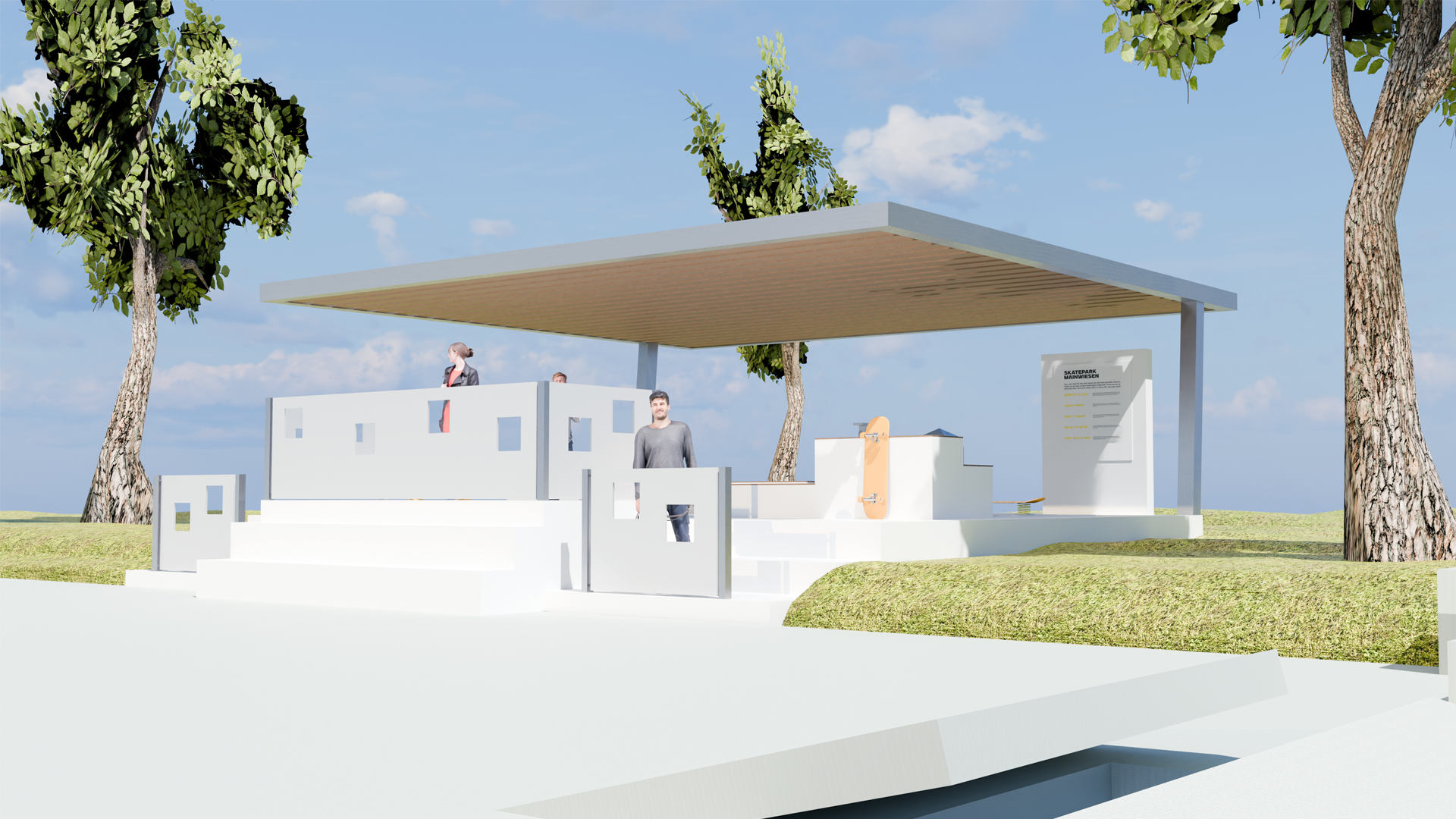



↘

Tools of Protest
Lucca Kreuzer, Luisa Thomsen, Tim Smits
Das Projekt Tools of Protest beschäftigt sich mit Protest als wichtige Partizipationsform in einer funktionierenden Demokratie. Diverse Gegenstände, die für verschiedene Formen des Protestes stehen, sind in drei verschiedenen Werkzeugkoffern angeordnet. Die Koffer machen ein Spektrum an Illegalität sowie gesellschaftlicher Akzeptanz der verschiedenen Protestformen auf: von harmlosen und allgemein akzeptierten Formen wie das einfache Demonstrieren bis zu destruktiven Arten des Meinungsausdrucks wie das Werfen von Steinen. Durch das provokatives Darstellen auch weniger akzeptierten Protestformen soll ein gesellschaftlicher Dialog entstehen.



↘

An Outside Space
Zeynep Aslı Kılıç
In this project, it was aimed to find a solution for people who stay in student dormitories and do not have a place to sit and spend time outside their homes. Like a backyard.
This movable, dismountable mobile structure is made of recycled plastic and solar panels.



